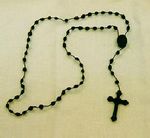| Part of a series on the |
| Rosary of the Catholic Church |
|---|
 |
| Overview |
| Prayers and promises |
| Writings |
| People and societies |
|
|
There are differing views on the history of the rosary, a [Catholic] prayer rope, cord or chain used to count specific prayers, commonly as a Marian devotion. The exact origin of the rosary as a prayer is less than clear and subject to debate among scholars. The use of knotted prayer ropes in Christianity goes back to the Desert Fathers in the 3rd and early 4th centuries. These counting devices were used for prayers such as the Jesus Prayer in Christian monasticism. The period after the Council of Ephesus in 431 witnessed gradual growth in the use of Marian prayers during the Middle Ages.
The practice of meditation during the praying of the Hail Marys was attributed to Dominic of Prussia (author of Liber experientiae 1458), a 15th-century Carthusian monk, who called it the "Life of Jesus Rosary" (vita Christi Rosarium). However, in 1977, a theologian from Trier named Andreas Heinz discovered a vita Christi rosary that dated to 1300, suggesting the origin of the current rosary extends back at least to that time.[1][2]
In 1569, the papal bull Consueverunt Romani Pontifices established the devotion to the rosary in the Catholic Church. The Christian victory at the Battle of Lepanto in 1571 was attributed to the praying of the rosary by masses of Europeans based on the request of Pope Pius V and eventually resulted in Our Lady of the Rosary. In 2002 Pope John Paul II introduced the Luminous Mysteries — based on a compilation by George Preca, the first Maltese saint — as an option in an apostolic letter on the rosary, Rosarium Virginis Mariae.
- ^ Winston-Allen, Anne. Stories of the Rose (University Park, PA: Pennsylvania State University Press, 1997), p. 17
- ^ Heinz, Andreas. Die Entstehung des Leben-Jesu-Rosenkranzes, in Der Rosenkranz: Andacht, Geschichte, Kunst, editors, Fredy Bühler and Urs-Beat Frei. (Bern: Verlag Benteli/Museum Bruder Klaus Sachseln, 2003), pages 23–47.